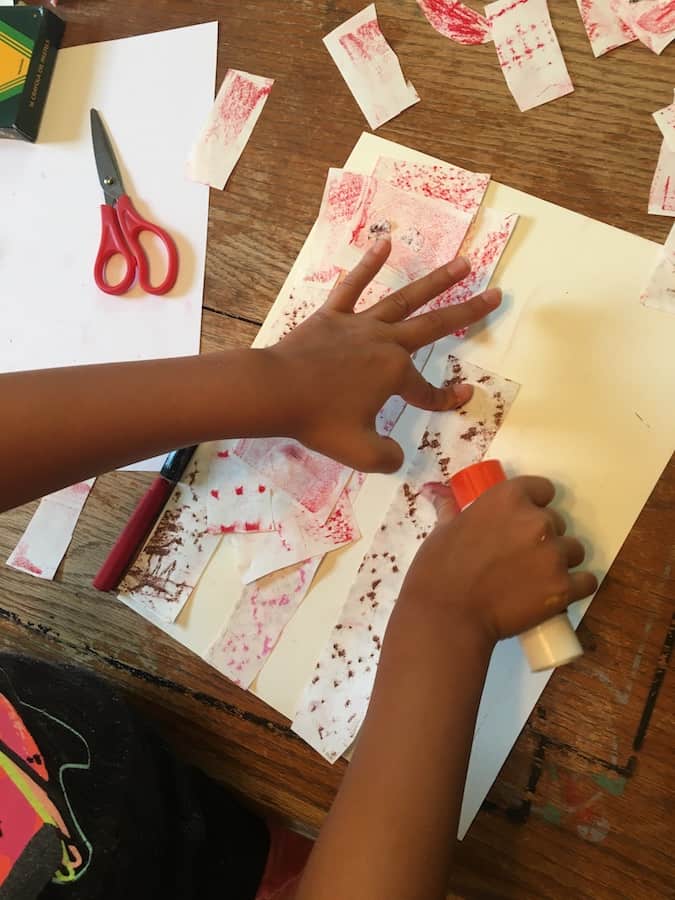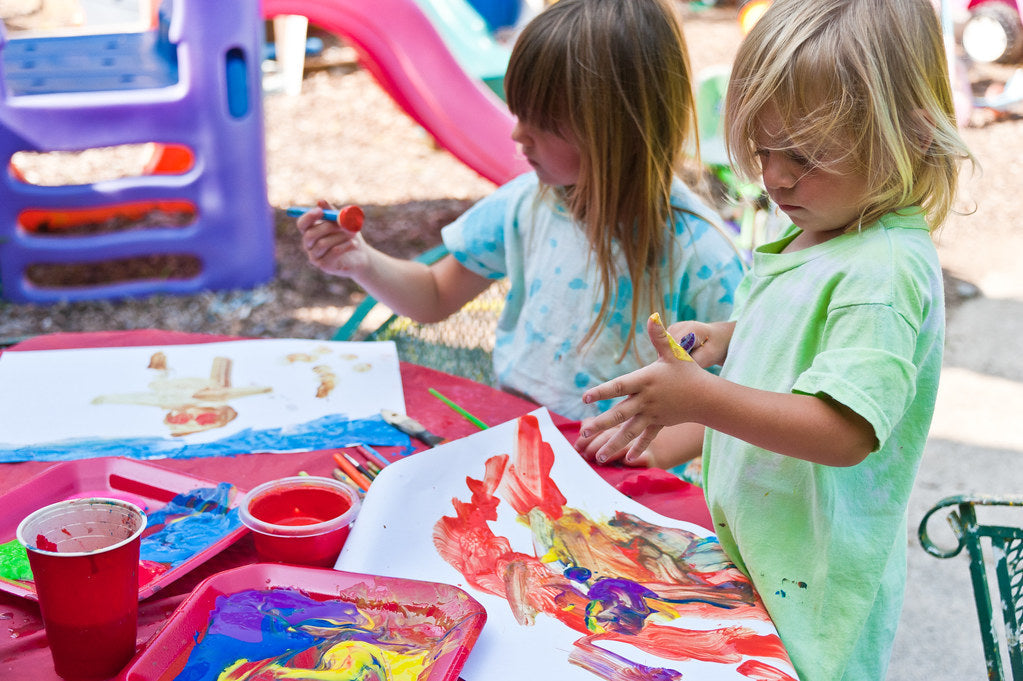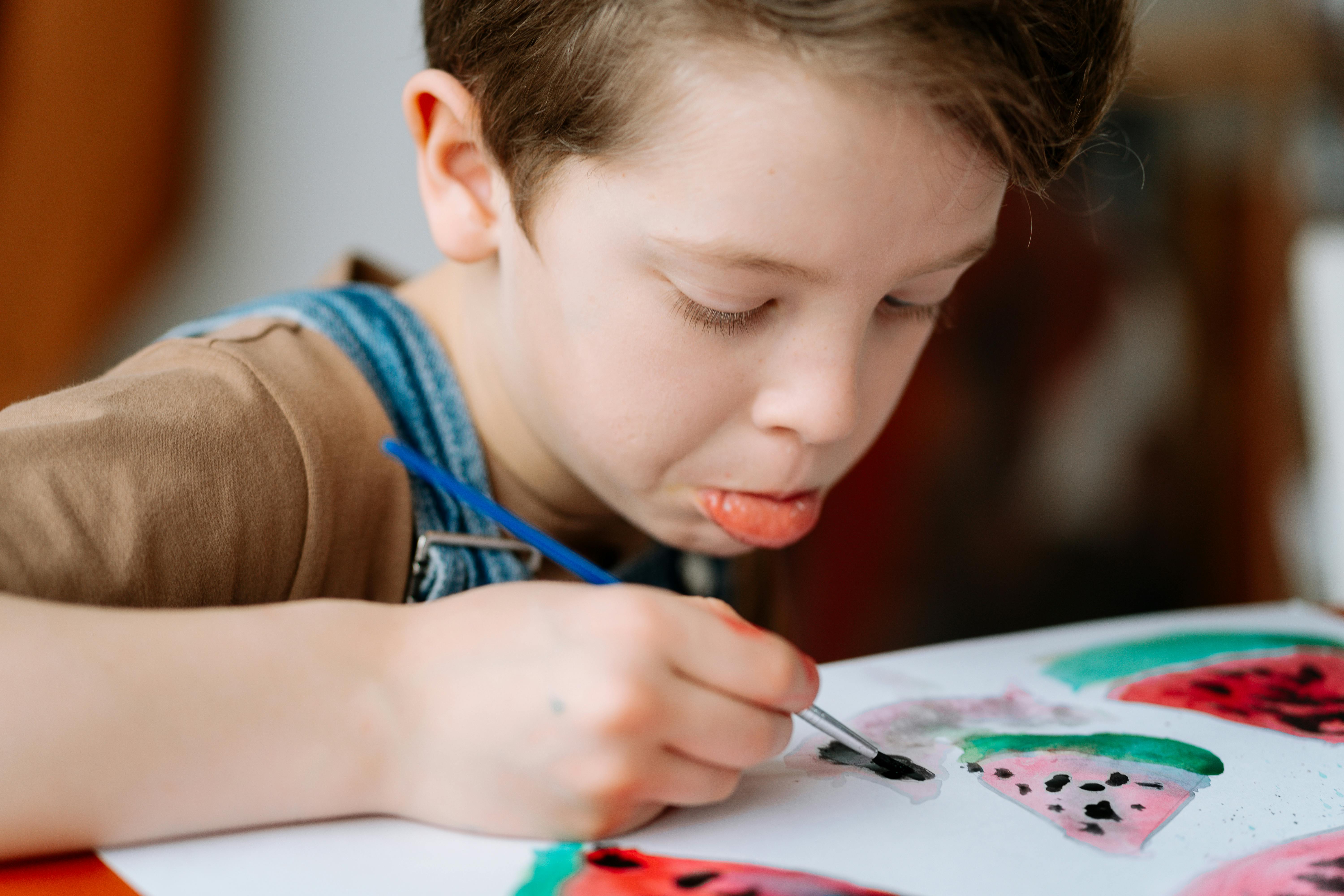
What basic supplies should I get to do art with my kids? (It’s not what you think!)
July 18, 2022
By Beth Herrild
I’m often asked: “What basic supplies should I get if I want to do art with my kids?” Your likely goal is to give your child all the benefits of a visual arts education: Increased creativity and creative problem solving skills, new synapses in the brain, higher overall academic achievement, increased empathy, and self-esteem, and of course, fun! It may even lead to a lifelong hobby or career that will provide your child with joy, satisfaction, and a means to earn a living. What if I told you that the actual art supplies you use aren’t as important as you may think?

Mindset – the most important supply :
The most important supply you need for giving your child all of the benefits of a quality visual arts education is not something you can purchase at an art supply store; it’s a mindset! Is that surprising? Having some good quality art supplies can really enhance your child’s experience. We’ll get to that later. But the fact of the matter is, your child can get all of the benefits of doing art and have fun without having a lot of sophisticated art supplies, as long as you have the right mindset. And, the opposite is also true. Even if you purchase wonderful, high quality art supplies, if you don’t have the right mindset, your child may not enjoy doing art, learn, or grow from the experience!
•Cultivating curiosity with your kids. What if several times per day you threw out “I wonder” questions to your kids and didn’t answer them yourself? For instance, I wonder why the sky is that color. I wonder how many shades of green we could find in that forest. I wonder why the mountains look greyer and lighter as they get farther away. You could ask your kids what kinds of things they’re curious about and help them keep a list or journal of things they’d like to investigate. The most creative and interesting adults I know approach life with an attitude of curiosity. Steve Jobs defined creativity “just connecting things”. Creative people see connections where others don’t.
•Promoting mistakes as something good! If you aren’t making mistakes you aren’t risking and trying new ideas! Sir Ken Robinson said, “If you’re not prepared to be wrong, you’ll never come up with anything original.” This is harder than it sounds. We adults must resist the temptation to always step in and show kids how to do things. Whether kids are working on art projects or trying to figure out how to change a battery in a toy, it’s important to let them struggle a bit and come up with their own solutions. Then, when and if they ask for help, you can start by asking them an empowering question: “What have you tried so far?” and then “What other ideas do you have?” They may come up with the winning solution just by talking about the problem like this; or you might then brainstorm different ideas with them. Helping kids understand that not only are mistakes not bad, but there is often more than one correct way to solve a problem. This insight will serve them well, in art and all other areas of life.
•Cultivating a growth mindset. There is a myth about art that you are either born with artistic ability or not. While some people are born with more of an innate artistic ability, more than 90% of art is learned skills and habits. As Macklemore said in his song, Ten Thousand Hours, “The greats weren’t great because at birth they could paint.The greats were great because they’d paint a lot.” So if your child says, “I’m not good at drawing,” the right answer is “Not yet!”
•Engaging in activities that help your kids learn to really notice things. This sounds super simple, and for some kids it is. But many of us spend a lot of time in our heads and aren’t really all that observant. This may be especially true if your child is in the Asperger’s range of the autism spectrum or is just a super type A kiddo who is constantly thinking about the next thing to do. So much of art is about really seeing things. The reason drawing feels so difficult to many people, is because our brains want to draw an object like we think it should be drawn, not like we really see it. For that reason, if you are doing a drawing project with kids and drawing something from a picture, I often suggest turning the picture upside down so that you trick your brain into just seeing shapes, rather than a dog or a tree. You can’t be a good artist if you don’t notice all of the different colors in the sky when you’re trying to paint it, or subtle differences in value or shading.
Actual art supplies, specifically paper
Now that you have the mindset nailed, there are some basic supplies I’d recommend having on hand. First, let’s define what an art medium is. A medium, in art, is the substance or material that is used to create the artwork. For instance, the medium that Monet used in his water lilly paintings was oil paint. Oil paint was the most popular medium for artists for many years. Now we have many more choices. We have acrylic paint, watercolor paint, gouache, colored pencils, soft pastels, oil pastels, etc.
Consider the quality. Definitely, quality art supplies will help your child have a better art experience, but there’s a sweet spot in between way too expensive and super cheap. A few of the overall solid art supply brands I recommend are:
•Strathmore for paper *when you want to use quality paper
•Faber-Castell for a variety of products from colored pencils to watercolors
•Art Advantage, a solid quality student-grade line with a variety of products
•Crayola for crayons & tempera paint
*Let’s talk about paper. There are definitely some times when you need to use paper that is higher quality than printer paper or scrap paper. For instance, if you’re learning how to do watercolor washes, you should use paper that won’t wrinkle all up immediately when it gets wet. This can cause kids to feel frustrated and can impede their ability to learn techniques with the watercolor medium.There may also be times that you want to use paper that is specifically made for use with pastels or mixed media.
I’m also a huge advocate for having stacks of cheap paper readily available for kids at all times! This paper can be printer paper or even scrap paper from your recycle bin. When kids are only given expensive paper, it can create anxiety and inhibit their creativity and learning because they are too afraid to make mistakes! This is a huge issue for many kids, particularly if your child has any perfectionist tendencies. Generally, if you think you may want to save a piece of your child’s artwork for a very long time, it is advisable to use paper that is acid free because it will age without yellowing and fading. However, one way to get around that is to photograph or scan your child’s artwork so that you can save it digitally and reproduce it easily to frame.
If you want to save your child’s artwork, especially if it is on lower quality paper, you can scan or photograph it. In most cases, scanning is better than photographing. Scanning will usually give you a higher quality image. There are a few exceptions to this, like if the artwork is 3-dimensional or sometimes if it has lots of layered texture. You can use a flatbed scanner if you have access to one. This can be a home scanner or you can take it to a business that offers that service. You can also download a variety of different free scanning apps onto your smartphone. Or, if you have an iPhone, you can use your notes app! Go into your Apple notes app and click the little pencil to create a new note. Then, down at the bottom, you’ll see a little camera icon. Click the camera icon and you’ll see a menu pop up that gives you choices that include scan documents. It will direct you to center the phone over the artwork and automatically scan the image. Then hit save. When you want to print out the scan or send it to someone, go back into your saved notes.Open that note and click the three dots in the upper right hand corner. Choose send a copy and you can send it to a printer, send it to someone in a text or email, or airdrop it. For easy creative ways to display your child’s art, read our blog post.

Basic art supplies
Please note that this post contains affiliate links for the supplies so that you can easily purchase the ones you want. We receive a very small commission when you purchase through these links (which we hope you’ll do). These do not change your price at all!
Pencils: Almost any pencil will work. If you want to get drawing pencils, we like General Pencil’s Carbon Sketch Drawing Pencil. Harder pencil leads draw lighter lines (your run-of-the-mill H or HB pencil) and are best for rough sketching. Softer darker leads are best for shading (3B-5B for mid tones and 6B-8B for darker shading.) I’m not a huge fan of erasers. We want kids to be relaxed and free with their drawing instead of erasing a lot, but it’s probably a good idea to have an eraser that works well available, like the Faber-Castell Dust-Free Eraser. If your child is advanced at drawing, a kneaded eraser is the gold standard.
Paper: as a parent who wants to encourage your kids to engage in art projects, have lots of drawing paper available. As we discussed above, printer paper and junk mail actually even work pretty well for daily drawing paper. By having stacks of inexpensive paper readily accessible, it takes pressure off of kids to have to be perfect! If you want a paper that is specifically for drawing, look for a sturdy white paper, at least 8 ½ x 11. Strathmore has an entire line of kids’ papers. Their youth drawing pads or marker pads will work great for pencil, colored pencil & markers and they aren’t super expensive. They also have a great paint pad of watercolor paper that is a reasonably priced good quality watercolor paper for watercolor and other types of paint.
Crayons: I’d go with good ole Crayola. Cheaper crayons often disappoint and frustrate young artists; more expensive ones aren’t necessarily better.
Scissors: if you have scissors at home already, I’d use what you have. If you find that you want some better kid sized scissors, I like Fiskars pointed tip kid scissors. For older kids, Fiskars is still a great brand!
Glue: Glue sticks work well for a multitude of kids’ art projects. Get Elmers, or another trusted brand though! If you want to get a liquid glue, we like Aleene’s Fast Grab Tacky Glue.
Markers: Markers should be fun to use & juicy! The size and type of marker you get should depend on the age & maturity of your child. Younger kids should have broader tip markers that won’t be ruined if the caps are left off a while, like Faber-Castell Jumbo Broadline Markers. We love them because they’re juicy, washable, non-toxic (made with food based dyes), and if the markers dry out, they can be rejuvenated by dipping in water and replacing the caps! If your child is ready for a smaller tip, the Crayola Fine line Markers are great. If you want to invest in something a little more expensive, we love these Tombow dual-tip markers. They’re great quality and one end is a nib while the other end is a brush, so that’s fun!
Paint: You really can use almost any paint you have starting out. If you’re going to purchase paint, we recommend good quality watercolors to start. Beware of super cheap watercolor sets. Kids often have a tough time loading their brushes with pigment when using those sets of dry paint cakes, so look for one that is more moist and soft, like this Faber-Castell set that even comes with a brush. Or use liquid watercolor, like Watercolor Magic, that you would then dilute.
Brushes: Brushes can be tough. I like to feel them before I buy them and find it tough to purchase online unless I know exactly what I want. Get a few sizes that are appropriate for all water mediums so they are versatile, like these Princeton Snap brushes. The key with brushes is to get good enough quality but not overly expensive. A lot of the brushes that are specifically labeled for kids, are really terrible, but on the flip side, you can spend a fortune on brushes and they can get ruined. Princeton is generally a good brand. There are also water brushes that hold water in the handle. In theory, these sound really great. They would be good to use if you’re planning a trip and want kids to be able to paint with reduced fuss and mess, but in general, kids will find these brushes very frustrating and we wouldn’t recommend them.
Air-Dry Clay: Our favorite air-dry clay is Creative PaperClay because it’s soft and malleable, non-toxic, and dries without baking. If your kids are really young and inexperienced with clay, you might start with Crayola Model Magic. It’s air dry too. Both clays can be colored with a variety of different materials (markers, paint etc., when they are dry.)
Those are the basic supplies. You can add other things over time ….or not.
Something else to consider
Here’s something else to consider, having limited choices of supplies can actually be really beneficial in terms of creativity and art. This sounds counter intuitive, but when kids (or adults for that matter), have too many choices, it can be paralyzing. Offering up a limited amount of supplies and giving kids some techniques to try and a challenge can be a really effective way to get their creativity flowing! Once you’ve got some supplies & the right mindset, read our blog post on how to create art invitations for your child.


